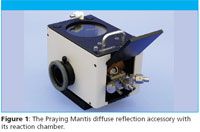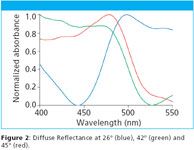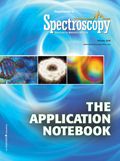UV-Vis Diffuse Reflectance of Thermochromic Materials Including Color-Changing Paint
Some powders and rough surfaced solids change color as a function of temperature, a phenomenon known as thermochromism. Such phenomena can be effectively studied by UV-Visible spectroscopy in combination with a diffuse reflection accessory equipped with temperature-controlled reaction chamber, as demonstrated here with a thermal paint.
Abstract
Some powders and rough surfaced solids change color as a function of temperature, a phenomenon known as thermochromism. Such phenomena can be effectively studied by UV-Visible spectroscopy in combination with a diffuse reflection accessory equipped with temperature-controlled reaction chamber, as demonstrated here with a thermal paint.

Figure 1
Introduction
Many materials undergo electronic transitions upon heating which can be studied by UV-Vis spectroscopy. Most often, the samples studied by this method are liquids. The liquid is simply poured into a thermostated cuvette for transmission analysis. Analysis of powders and other solids is less straightforward, unless they can be dissolved and measured as a liquid.
For non-soluble solids, the only feasible methods for such analysis in the UV-Vis are specular reflectance and diffuse reflectance. The former is suitable for highly reflective materials; the latter for powders and roughened solids. Both require a mirror assembly to direct the radiation to and from the sample, in addition to a thermostated sampling stage.
This note explores the use of diffuse reflectance to probe the temperature-induced color changes of a rough surfaced solid at varied temperatures.
Experimental
The diffuse reflectance measurements were carried out in a commercial UV-Vis spectrometer, using Harrick's Praying Mantis™ diffuse reflection accessory equipped with its High Temperature Reaction Chamber. The temperature of the chamber was controlled using Harrick's Automatic Temperature Controller. The controller was connected to the reaction chamber and initially auto-tuned at 40°C. Several measurements were then taken around that temperature.
The sample investigated was a Thermal Liquid Crystal Paint (Edmund Scientific, 3053489) with color changes in the 40–45°C temperature range. The paint was applied to one end of a sandblasted 316-stainless steel rod which fits into the sample cup of the reaction chamber.
The diffuse reflectance spectra were measured using a UV-Vis spectrometer in its double-beam mode with an open slit, a 2-nm SBW and a 5-nm data interval.
Results and Discussion
Figure 2 shows the spectra of the sample recorded at three different temperatures. At the lowest temperature, the spectrum has a peak at 500 nm, in the green region of the visible. As the sample is heated, the peak at 500 nm decreases in intensity and another peak arises at 480 nm, in the blue. Thus this particular paint changes color in the blue-green region of the visible spectrum as a function of temperature.

Figure 2
Conclusion
In conclusion, it is clear that diffuse reflectance, using the Praying Mantis with its high temperature reaction chamber, is an effective way of measuring temperature induced color changes in the visible spectral region. Hence this method can be a useful tool for probing electronic transitions of powders and other solid materials at elevated temperatures.

Harrick Scientific Products, Inc.
141 Tompkins Ave., 2nd floor, Pleasantville, NY 10570
Tel. (914) 747-7202, Fax (914) 747-7409

Smarter Sensors, Cleaner Earth Using AI and IoT for Pollution Monitoring
April 22nd 2025A global research team has detailed how smart sensors, artificial intelligence (AI), machine learning, and Internet of Things (IoT) technologies are transforming the detection and management of environmental pollutants. Their comprehensive review highlights how spectroscopy and sensor networks are now key tools in real-time pollution tracking.
New Study Reveals Insights into Phenol’s Behavior in Ice
April 16th 2025A new study published in Spectrochimica Acta Part A by Dominik Heger and colleagues at Masaryk University reveals that phenol's photophysical properties change significantly when frozen, potentially enabling its breakdown by sunlight in icy environments.